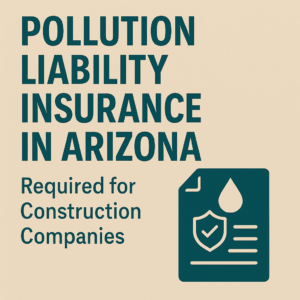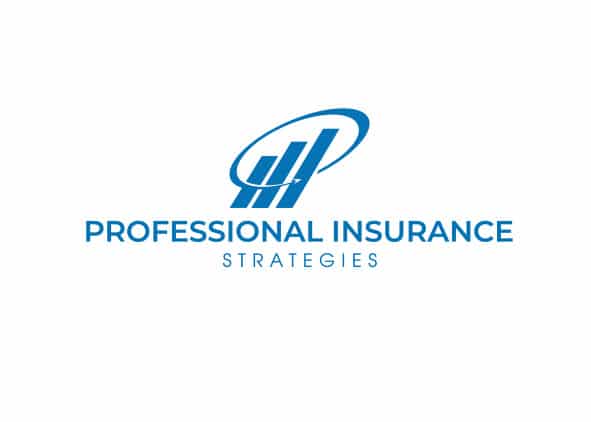Pollution Liability Insurance: Construction Firms in Arizona Need It
In recent years, public agencies and municipalities in Arizona — including the State of Arizona and the City of Phoenix- have increasingly demanded stronger environmental protection safeguards in construction contracts. One of the critical elements is pollution liability insurance (sometimes called Contractors Pollution Liability or environmental liability coverage). For construction companies, understanding when and how pollution liability insurance applies is essential; failing to comply can mean losing bids, facing legal exposure, or being forced to purchase expensive coverage at the last minute. If you need a quote please give us a call.

This post covers:
- The nature of pollution liability insurance
- Why has it become more common in public contracting
- Specific Arizona statutory and municipal drivers
- Key policy terms and coverage features to watch
- Practical advice for contractors in Phoenix and across Arizona
What Is Pollution Liability Insurance?
Pollution liability insurance is coverage intended to protect against environmental risks that are excluded from standard general liability policies. Some key features:
- It can cover first-party costs, such as cleanup, remediation, and response to a pollution release on property you own or control.
- It can also cover third-party claims for bodily injury, property damage, or environmental harm to neighbors or downstream parties, allegedly caused by your operations.
- Coverage may be written on either a claims-made or occurrence basis.
- Many contractors use it as a project-specific policy (covering a defined scope and period) or blanket/operations coverage (covering work across multiple projects).
- It may include extensions for “sudden and accidental” pollution, gradual pollution, mold, asbestos, underground releases, non-owned disposal sites, transportation, and more.
Because general liability (GL) policies routinely exclude pollution risks, many pollution exposure claims are not covered unless a separate pollution liability policy is in place.
Why Public Entities Are Requiring Pollution Liability Insurance More Often
1. Heightened Environmental Awareness & Risk
Municipalities and public agencies are under greater pressure to manage environmental risk, protect public health, and avoid long-term liabilities from contamination. Requiring pollution liability insurance shifts some of that risk to contractors and ensures accountability.
2. Increased Regulatory and Cleanup Costs
Environmental laws and cleanup standards have become stricter, and the cost of remediation (soil, water, groundwater, vapor intrusion) can be enormous. Public entities want assurance that contractors are financially capable of addressing issues that may arise from their work.
3. Contractual Risk Allocation
By demanding pollution liability insurance, public owners (or agencies) can more clearly allocate risk: the contractor bears responsibility for pollution arising from their activities. It also helps protect the public agency (or the municipality) from being dragged into costly claims or remediation.
4. Underwriting Pollution Liability Insurance & Financial Assurance
Having pollution liability insurance in place provides certainty and financial backing, which may be preferable to self-insurance or post-claim indemnities. In larger projects, some owners may adopt owner-controlled insurance programs (OCIPs or wrap policies) that include contractors’ pollution liability coverage as part of the overall risk management structure.
Arizona & Phoenix: Local Drivers & Requirements
State-Level Requirements in Arizona
- The Arizona Department of Environmental Quality (ADEQ) requires pollution liability insurance (or equivalent financial responsibility) for underground storage tanks (USTs). A valid policy, complete with a certificate of insurance, is required for compliance with financial responsibility rules. (ADEQ)
- Under the Arizona Department of Administration’s Insurance and Indemnification Guidelines, state contracts requiring “special operations” may mandate Pollution Legal Liability coverage. (spo.az.gov)
- For contractors licensed under Arizona’s Registrar of Contractors (ROC), maintaining adequate insurance (liability, workers’ comp, etc.) is already a condition of good standing. While ROC does not always explicitly mandate pollution liability insurance across all trades, it is increasingly considered part of a modern, responsible contractor’s coverage suite.
City of Phoenix & Local Permitting Requirements
- The City of Phoenix requires contractors performing right-of-way (ROW) work or obtaining specific construction permits to submit a Certificate of Liability Insurance. The city code states the contractor’s liability must include coverage with no exclusions for explosion, collapse, and underground operations. (Phoenix)
- For public works projects and contracts, Phoenix often requires that the City be named as Additional Insured to the full limits of liability purchased by the contractor. (Phoenix)
- The Phoenix “Requirements for Permit Issuance” includes submission of a Certificate of Liability Insurance (ACCORD form) per city code. (Phoenix)
- A Phoenix municipal license (e.g., business or trade license) may also require liability insurance, including coverage for incidents involving underground utilities. Under Phoenix City Code § 5A-20, licensees must provide insurance covering explosion, collapse, and underground incidents, among other exposures, and name the City as additional insured. (Phoenix Municipal Codes)
- For work costing over $50,000, the city’s required liability limit is at least $1,000,000 combined single limit; lesser jobs may need $500,000. (Phoenix)
So, in practical terms: if you’re a contractor doing permitted work or public contracts in Phoenix, you should anticipate needing pollution liability coverage (or a policy broad enough to include pollution exposures) and meet the city’s insurance protocols.
Key Policy Terms & Considerations for Pollution Liability Insurance
When purchasing or negotiating pollution liability insurance coverage, contractors should pay attention to:
| Feature | Significance / Pitfall | Tips |
|---|---|---|
| Policy Form: Claims-made vs Occurrence | Many policies are claims-made, meaning the pollution event must both occur and be discovered (and reported) within the policy period or an extended reporting period. Without proper retroactive dates and tail coverage, you could lose coverage. | Ask for a policy with an adequate retroactive date, and negotiate for an extended reporting period or “tail” coverage for completed operations. |
| Scope / Trigger | Does the policy cover gradual pollution (e.g., slow leaks) in addition to sudden accidents? | Insist on “pollution condition” or gradual coverage if your work risks long-term exposures (e.g., buried pipes, landscaping, utility work). |
| Cleanup & Remediation Costs | Some policies cap the amounts for remediation / corrective action vs third-party liability. | Please make sure that cleanup and corrective action are covered, not just third-party lawsuits. |
| Additional Insured & Waiver of Subrogation | Public agencies often require being named Additional Insured and may require a waiver of subrogation to prevent the insurer from pursuing the owner. | Confirm the policy endorsement or schedule appropriately names the public agency as Additional Insured and includes any required waivers. |
Exclusions |
Standard exclusions include pollution from intentional acts, non-owned disposal sites, prior contamination, etc. |
Carefully review all exclusions and negotiate to remove or narrow critical ones where possible. |
| Limits, Deductibles & Retention | High deductibles or retentions can undermine the utility of the policy. | Seek a balance: a deductible you can manage, with limits that cover worst-case exposures. |
| Policy Cancellation / Notice | Public contracts often require prompt notice (e.g., 30 days) of cancellation or modification. | Could you make sure the insurer agrees to the contract-required notice period? Phoenix, for example, demands notice within two business days of cancellation. (Phoenix) |
| Operations vs Project-Specific Coverage | Project policies may be limited to a given contract; operations policies cover all work. | If you’re a contractor working across multiple sites, a blanket operations pollution policy may afford better consistency. |
| Tail / Extended Reporting Period | After a project ends, claims may arise later. Without a tail, coverage might not respond. | Negotiate for at least a several-year tail or extended reporting period for long-term exposures. |
Steps for Contractors in Phoenix / Arizona to Comply & Stay Competitive
-
-
-
- Please take a look at your environmental exposures.
>>Even seemingly “clean” construction can have pollution risks (e.g., excavation encountering contaminated soil, fugitive dust, stormwater runoff, dewatering, use of chemicals or diesel equipment, underground utilities). Identify which of your projects carries a higher risk. - Could you talk with specialized brokers?
Work with insurance brokers experienced in environmental risk. Many standard commercial brokers may not fully understand CPL or pollution liability products. - Could you build the insurance requirement into your bids?
When preparing proposals for public entities, include the cost and availability of pollution liability coverage. Don’t wait until contract award to scramble. - Could you negotiate contract language early?
Before signing a public contract, please make sure the required insurance endorsements (additional insured, waiver of subrogation, notice of cancellation, retroactive dates, tail rights) are acceptable and doable. If a public agency’s requirements are too onerous, you may negotiate modifications or obtain clarifications. - Please make sure to maintain continuous coverage & document properly.
Be vigilant about renewal, endorsements, and policy renewals. Ensure certificates submitted to municipalities are accurate and reflect all required coverage. For projects under public city or state jurisdiction, you may need to provide copies of policy forms, not just certificates. - Monitor regulatory changes
Environmental rules and municipal requirements evolve. For instance, newer stormwater rules, groundwater protection rules, vapor intrusion, and redevelopment of contaminated sites can generate new liabilities over time.
- Please take a look at your environmental exposures.
-
-
Consider risk-pooling or wrap programs for large projects
On mega-projects, an owner-controlled insurance program (OCIP / wrap-up) may centrally handle liability, including pollution coverage, reducing duplicative premiums and ensuring consistent coverage across contractors. The cost of pollution liability insurance will vary depending on project complexity, past loss history, soil/groundwater risk, coverage limits, and geographic location. To give a sense of scale, small businesses nationwide are quoted a median environmental liability cost of a round $223/month (~$2,675 annually).
However, larger contractors or riskier jobs will see much higher pricing
Demand for pollution liability insurance in Arizona
Increased need for pollution liability insurance for construction firms working on public projects is no longer just a theoretical risk-mitigation measure. It’s becoming a de facto requirement in permitting and contract compliance, particularly in Phoenix. Contractors that fail to anticipate this will, face expensive last-minute coverage, or be exposed to significant environmental liability. If your firm operates (or plans to operate) in Arizona, especially in Phoenix or other municipalities with stringent insurance requirements, it’s wise to:
-
- Please look at your environmental exposures now.
- Could you speak with a knowledgeable environmental / contractor insurance broker?
- Factor in the cost and requirements into your bids
- Ensure your insurance documentation is always up-to-date and compliant
